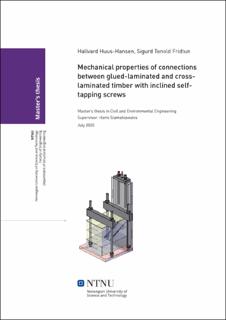| dc.contributor.advisor | Stamatopoulos, Haris | |
| dc.contributor.author | Huus-Hansen,Hallvard | |
| dc.contributor.author | Tenold Fridtun, Sigurd | |
| dc.date.accessioned | 2021-09-21T16:22:20Z | |
| dc.date.available | 2021-09-21T16:22:20Z | |
| dc.date.issued | 2020 | |
| dc.identifier | no.ntnu:inspera:56731605:15965932 | |
| dc.identifier.uri | https://hdl.handle.net/11250/2780059 | |
| dc.description.abstract | Målet med denne masteroppgaven er å undersøke egenskaper ved forbindelser mellom massivtre- og limtre elementer med selvborende skruer. Dette er gjort gjennom eksperimentelle forsøk, numeriske simuleringer og analytiske estimeringer. Studiet ble gjort i forbindelse med forskningsprosjektet woodsol, der målet er å utvikle et strukturelt system av trekomponenter basert på stive rammer og komposittdekker. Tidligere studier har tydeliggjort behovet for å kvantifisere stivheten av disse forbindelsene per enhet lengde. Disse egenskapene kan være nyttige, ikke bare for woodsol prosjektet, men også for utviklingen av andre løsninger knyttet til strukturell prosjektering basert på trematerialer (komposittbjelker, etc.).
Flere skruekonfigurasjoner med forskjellige antall skruer, helning på skruene og fiberretning på treverket ble testet eksperimentelt. En nylig utviklet lastprotokoll ble benyttet, med syklisk last I strekk- , trykk- og reverserte spenningsverdier. Stivheten, energitapet og kapasiteten av forbindelsen ble kvantifisert. I forbindelse med covid-19 situasjonen ble ikke alle planlagte skruekonfigurasjoner testet eksperimentelt.
Analytiske estimat av både stivhet og kapasitet ble utregnet. To metoder for å estimere stivheten ble benyttet- den ene utviklet av Tomasi med flere (2010), og den andre ble utledet i denne oppgaven. To metoder for å finne kapasitet ble brukt- den ene utledet fra Eurokode-5-1-1 (2010) og den andre utledet av Tomasi med flere (2010).
«Cohesive surface» elementmetode modellering ble brukt I de numeriske simuleringene. Et annet fokus ved oppgaven var å undersøke denne modelleringsteknikken, og å kalibrere de viktigste parametrene knyttet til dette. En fullstendig 3D elementmetode modell ble laget for de planlagte skruekonfigurasjonene, og et parametrisk studie ble gjennomført. Det ble undersøkt i hvilken grad friksjon og to parametre knyttet til skjærstivhet og skjærstyrke av «cohesive material», hadde på stivheten til forbindelsen.
Både eksperimentelle, numeriske og analytiske resultater viser at I tillegg til stivhetsbidraget av å øke antall skruer I en skjær-strekk konfigurasjon, så øker også stivheten av forbindelsen ved å legge til skruer i skjær-trykk (X-konfigurasjon). Stivheten øker også med økende skruevinkel. Kalibrering av modellen tilsier at parameteren knyttet til skjærstivhet bør ligge i et område fra 5-20 N/mm^3. | |
| dc.description.abstract | This thesis aims to investigate and assess the mechanical properties of connections between Cross-Laminated Timber (CLT) panels and glued laminated timber (glulam) elements with self-tapping inclined screws as fasteners. This was achieved through experimental tests, numerical simulations and analytical estimations. The study was conducted in context of the research project Woodsol, which aims to develop a structural system entirely from timber components, based on moment resisting frames and composite timber slabs. Previous research has suggested that it will be useful to quantify the stiffness per length of such a connection. These properties may be valuable, not only for theWoodsol project, but also for the development of new solutions in structural timber engineering (composite timber beams, etc.)
Several screw assembly configurations with different number of screws, screw inclination angles and grain directions were tested experimentally. A newly developed load protocol was used, with cyclic loading in tension, compression and fully reversed. The stiffness, energy dissipation and capacity of the connections were quantified. Due to unforeseen events (COVID-19) not all the planned configurations could be tested experimentally.
Analytical estimates of both stiffness and capacity of the connection were obtained. Two methods for estimating the stiffness were used, the method developed by Tomasi et al. (2010), and the other developed in this thesis. Two capacity estimation methods were used, one derived from Eurocode 5 (2010) and one derived by Tomasi et al. (2010).
Cohesive surface Finite Element modeling was used in the numerical simulations. A side objective of the thesis was to explore this modeling technique, and to calibrate the most important input parameters. Full 3D FE models of some of the planned configurations were created, and a parametric study was conducted. The influence of the friction coefficient and the withdrawal stiffness and withdrawal shear strength parameters kl and fl of the cohesive surface was investigated. Both the experimental, numerical and analytical results show that in addition to the stiffness contribution of adding screws subjected to shear-tension loading to the connection, the contribution of adding screws subjected to shear-compression (X-configuration) is significant. The stiffness also increases with the screw inclination angle. Calibrations suggest a cohesive withdrawal
stiffness parameter kl in the range of 5 20 N/mm3. | |
| dc.language | | |
| dc.publisher | NTNU | |
| dc.title | Mechanical properties of connections between glued-laminated and cross-laminated timber elements with inclined self-tapping screws | |
| dc.type | Master thesis | |
